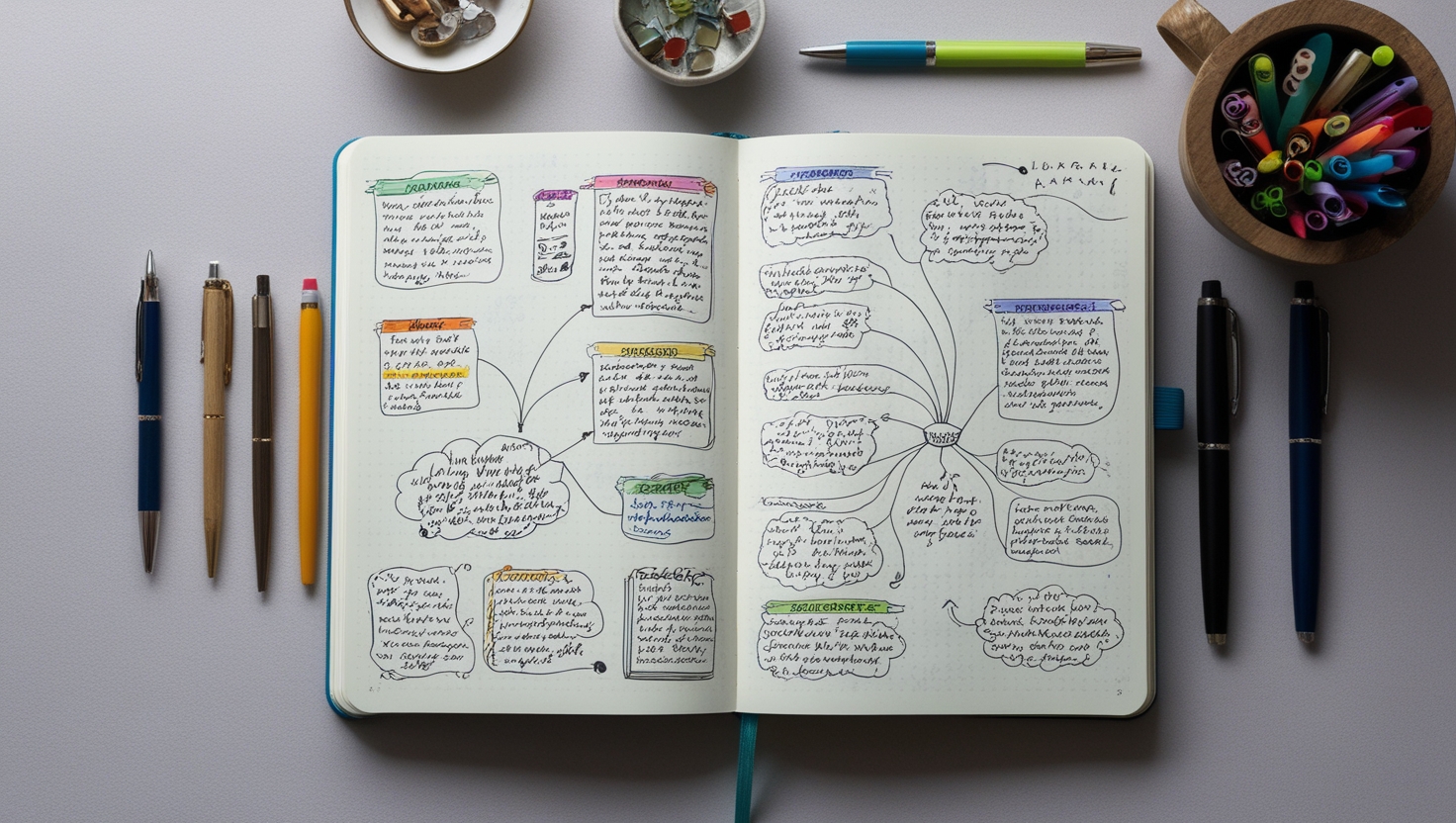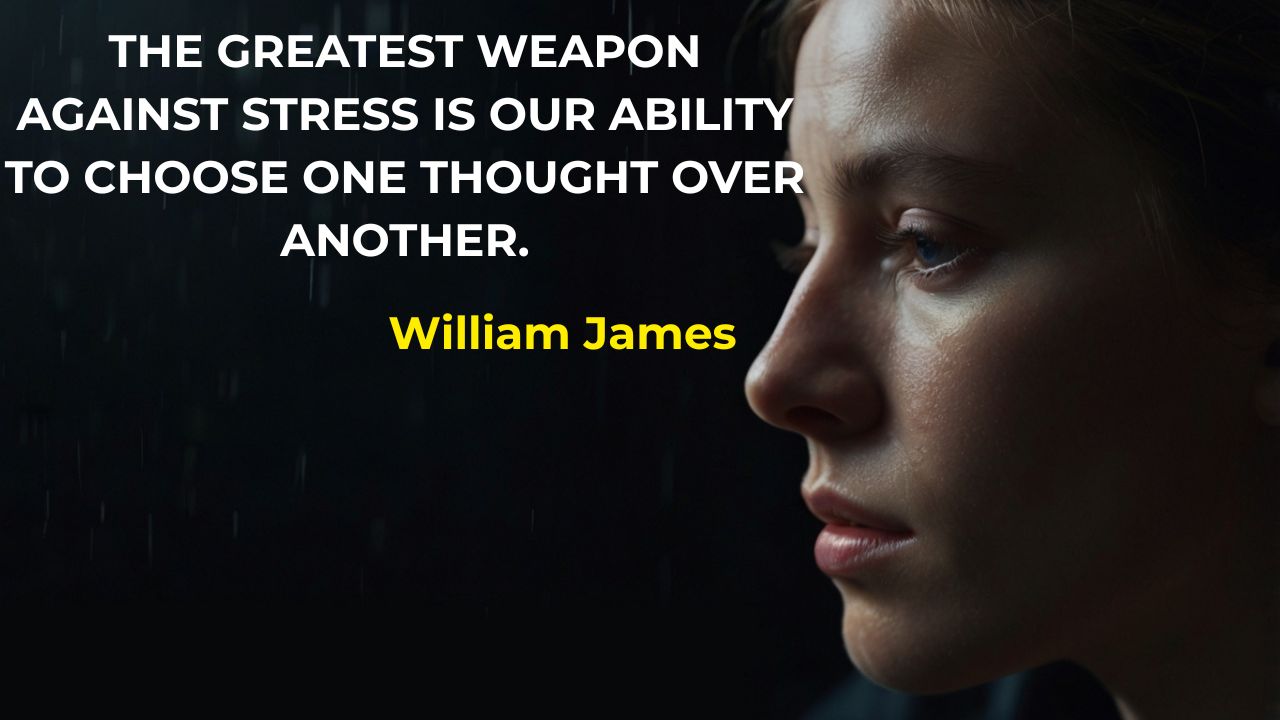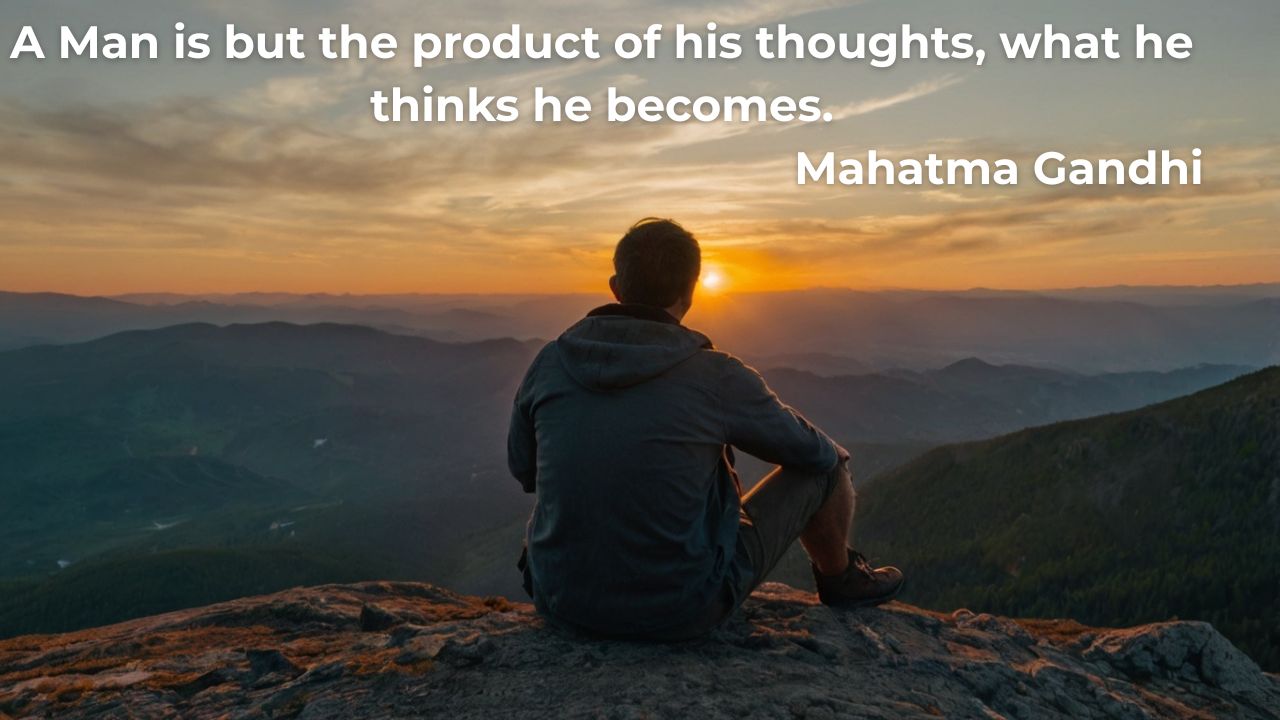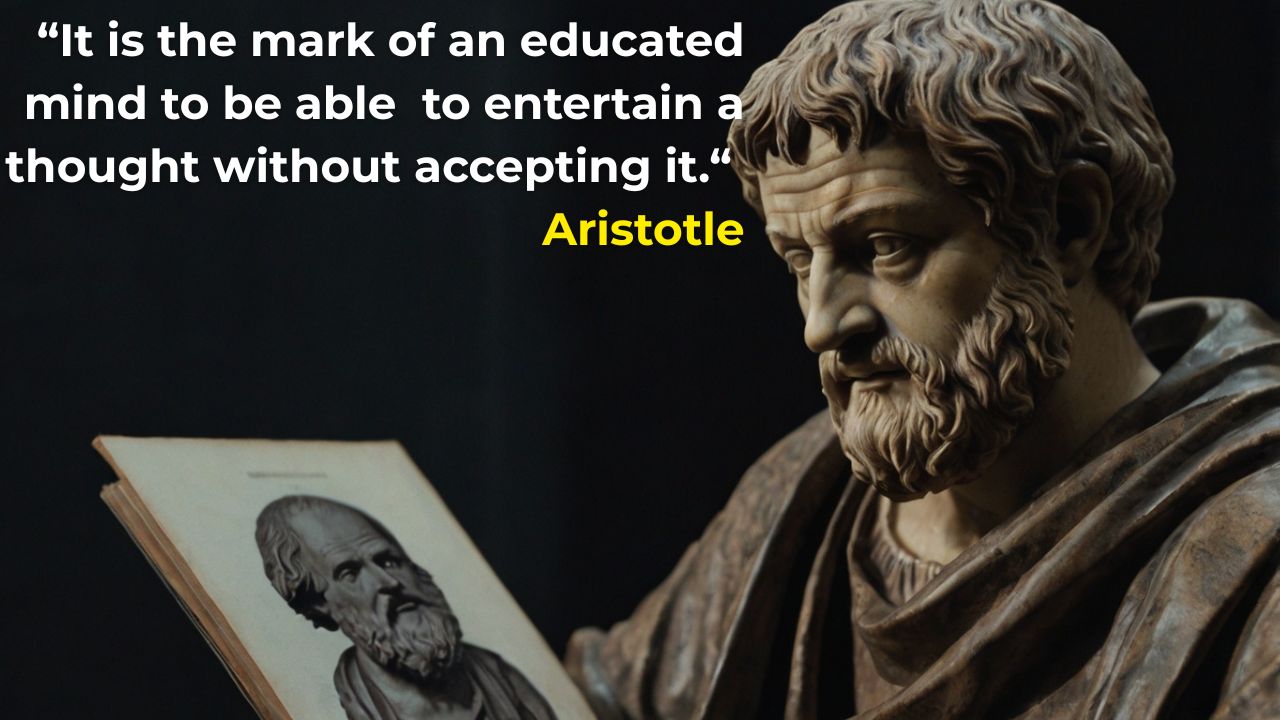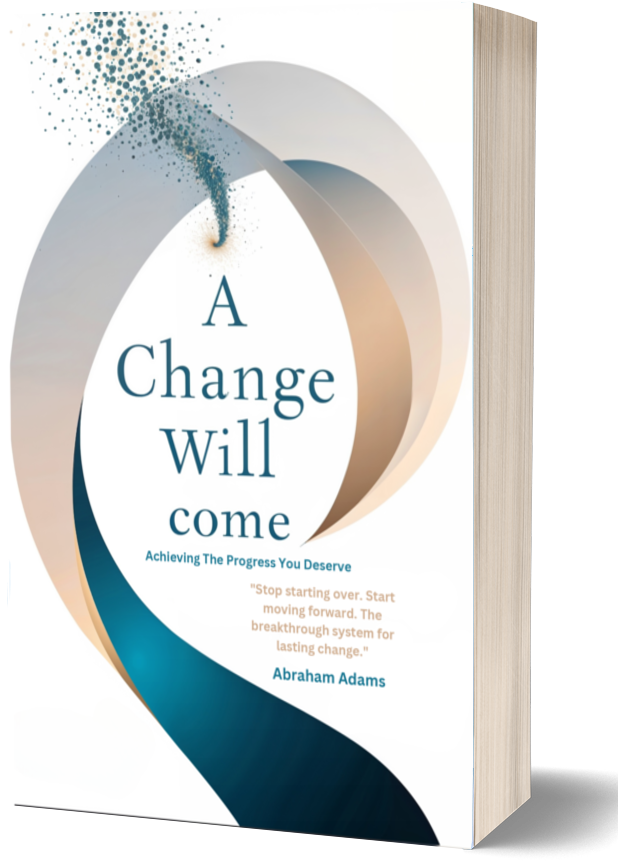Super User
Breaking Through - Finding and Removing What's Holding You Back
Breaking Through: Finding and Removing What's Holding You Back
In a world full of quick fixes and temporary solutions, the "Breaking Through" series offers something different - a practical way to understand how things really work and create lasting positive change.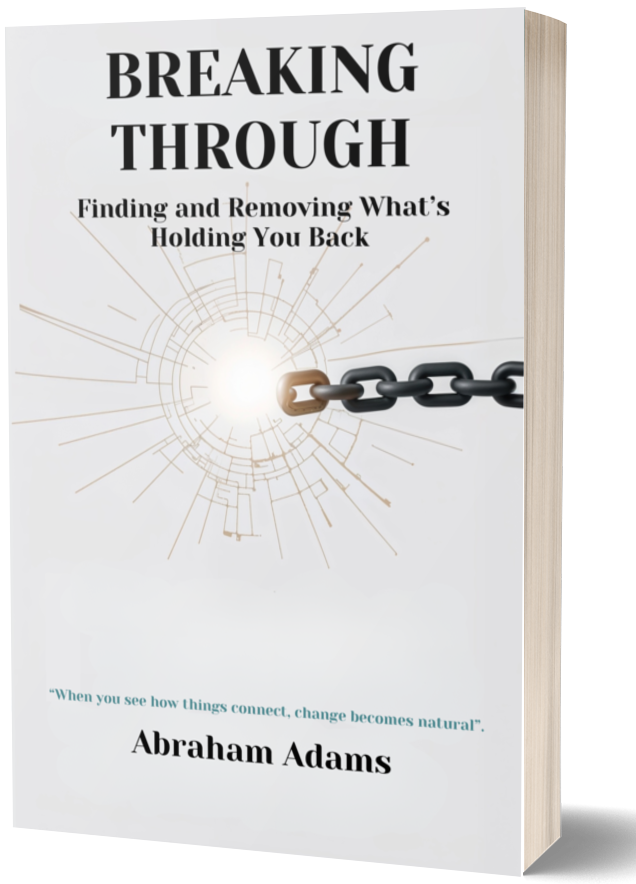
Book I, "Breaking Through - Finding and Removing What's Holding You Back," shows you how to see the hidden connections in your life and work. Using simple drawing techniques anyone can use (no artistic skill needed), you'll learn to spot what's really holding things back and create improvements that naturally last. Perfect for anyone wanting to make lasting changes in their personal life, work, or organization.
Book II, "Taking It Further - Your Journey of Continuous Growth," builds on these foundations, showing you how to handle more complex situations, work with multiple changes at once, and help others see more clearly. You'll discover how initial improvements can grow into larger positive changes, and how to create conditions where good changes multiply naturally.
Through engaging stories and practical exercises, these books show you:
- How different parts of life connect and influence each other
- Why some changes stick while others fade away
- How to spot the real limits holding things back
- Ways to create improvements that grow naturally
- How to help others understand and use these ideas
Whether you're improving your personal life, enhancing your work effectiveness, helping a team perform better, or creating organizational change, these books provide practical tools to see situations clearly and make changes that last.
Using everyday examples and simple techniques, you'll develop the ability to see and work with the patterns that shape your life and work. No complex theories - just practical ways to understand deeply and create positive change that grows naturally.
Start your journey to lasting improvement today with this comprehensive guide to creating positive change that sticks.
Overcoming Unwanted Habits
10 Steps to Overcoming Unwanted Habits
Breaking free from unwanted habits can feel challenging, but with the right approach, it’s entirely achievable. Here are ten practical steps to help you identify, address, and overcome habits that no longer serve you:
---
1. **Identify the Habit’s Trigger**
Every habit is triggered by a specific cue. Reflect on the circumstances, emotions, or environments that precede the habit. Awareness of these triggers is the first step toward breaking the cycle.
---
2. **Understand the Reward**
Habits persist because they fulfill a need or provide a reward. Determine what you gain from the habit—whether it’s comfort, distraction, or stress relief—to find healthier alternatives that provide similar benefits.
---
3. **Set Clear Intentions**
Clearly define why you want to eliminate the habit. Write down your goals and the positive changes you expect. A strong sense of purpose will keep you motivated during the process.
---
4. **Replace the Habit**
Instead of focusing solely on elimination, introduce a positive replacement. For example, if you tend to snack when stressed, replace it with a quick walk or a glass of water.
---
5. **Redesign Your Environment**
Adjust your surroundings to make the unwanted habit harder to engage in. Remove temptations and create an environment that supports your desired behavior.
---
6. **Use Accountability**
Share your goal with a trusted friend, join a support group, or track your progress publicly. Knowing others are aware of your efforts can increase your commitment.
---
7. **Break the Habit into Smaller Steps**
Overcoming a deeply ingrained habit can feel overwhelming. Break the process into manageable steps. For example, gradually reduce your habit’s frequency rather than quitting abruptly.
---
8. **Anticipate and Plan for Obstacles**
Expect setbacks and prepare for them. Create a plan for moments of stress, fatigue, or temptation. Knowing how you’ll respond can prevent relapse.
---
9. **Reward Progress**
Celebrate small victories along the way. Rewards reinforce positive behavior and keep you motivated. Choose meaningful rewards that don’t undermine your progress.
---
10. **Be Patient and Persistent**
Changing habits takes time and effort. Don’t get discouraged by slow progress or occasional setbacks. Stay consistent, and remember that each step forward is progress.
---
Final Thoughts
Overcoming unwanted habits is not about achieving perfection but about making consistent improvements. With self-awareness, intentionality, and persistence, you can break free from negative patterns and replace them with habits that align with your goals and values. Start today—one small step at a time—and watch as transformation unfolds.
Breaking Bad Habits: Your Roadmap After Habit Tracking
Breaking Bad Habits: Your Roadmap After Habit Tracking
So, you've been diligently tracking your habits for a few weeks. The patterns are clear, the triggers are visible, and now you're wondering: "What's next? How do I actually break these habits that are holding me back?" Let's dive into the strategic approach to dismantling those unwanted habits.
Understanding Your Habit Data
Before you can break a habit, you need to understand its structure. Your tracking data reveals three crucial elements:
- When the habit occurs (time patterns)
- What triggers it (environmental or emotional cues)
- What reward you're seeking from the behavior
Making Habits Impossible: The Strategic Approach
Creating Physical Distance
Your first move is to make the habit physically harder to perform. If social media is your vice, delete the apps from your phone. If late-night snacking is the issue, stop keeping snacks at home. The key is to create enough friction that your autopilot behavior gets interrupted.
Replacing the Reward
Every habit serves a purpose. Late-night scrolling might be your way of decompressing. Procrastination might help you avoid anxiety. Identify what reward your bad habit provides, then find a healthier way to get it. Want to decompress? Try reading or gentle stretching instead of scrolling.
The Implementation Strategy
1. Choose Your Battleground
Focus on one habit at a time. Trying to change multiple habits simultaneously is like trying to fight a war on multiple fronts – it divides your resources and attention.
2. Design Your Environment
Make your new, desired behavior the path of least resistance. Want to read more instead of watching TV? Leave a book on your coffee table and put the TV remote in a drawer.
3. Plan for Failure
Have a specific plan for when triggers occur. If stress leads to unhealthy snacking, decide in advance what you'll do instead – perhaps a short walk or breathing exercise.
Advanced Tactics
Habit Stacking
Attach your new, desired behavior to an existing habit. If you already have a solid morning coffee routine, use that as an anchor point for a new habit you want to build.
The 10-Minute Rule
When you feel the urge to engage in your unwanted habit, wait 10 minutes. Often, the urge will pass, and if it doesn't, you've at least created space for a conscious choice rather than an automatic response.
Identity Alignment
Frame your habit change in terms of identity. Instead of "I'm trying to stop procrastinating," think "I'm becoming someone who takes immediate action."
Measuring Success
Remember that habit change isn't linear. Track these indicators of progress:
- Decreased frequency of the unwanted habit
- Increased awareness before engaging in the habit
- Shorter duration when you do engage
- Growing comfort with your replacement behaviors
The Power of Community
Don't try to go it alone. Share your habit-breaking goals with others who can:
- Provide accountability
- Offer support during challenging moments
- Celebrate your progress
- Share strategies that worked for them
Moving Forward
Breaking habits is a skill that improves with practice. Each attempt, even if not entirely successful, teaches you something valuable about yourself and the habit-breaking process. Keep your tracking system going even as you implement changes – it will help you identify what's working and what needs adjustment.
Remember: The goal isn't perfection but progress. Every time you choose not to engage in an unwanted habit, you're rewiring your brain for better choices in the future.
Stay consistent, stay patient, and most importantly, stay committed to your transformation journey.
The Purpose and Benefits of Habit Tracking
The Purpose and Benefits of Habit Tracking
Habit tracking is a simple yet powerful tool that can help you build positive routines, break unproductive patterns, and maintain consistency in your journey toward self-improvement. By visually tracking your habits, you bring awareness to your actions, hold yourself accountable, and gain valuable insights into your progress.
Let’s explore the purpose and benefits of habit tracking and how it can become a cornerstone of your personal growth strategy.
---
The Purpose of Habit Tracking
The primary purpose of habit tracking is to bridge the gap between intention and action. It provides a tangible method to:
1. **Increase Awareness**: Habit tracking helps you stay mindful of your daily actions, ensuring that your efforts align with your goals.
2. **Measure Progress**: It provides a clear record of what you’ve accomplished, keeping you motivated and showing how far you’ve come.
3. **Identify Patterns**: By logging habits, you can uncover patterns, such as when you’re most productive or what triggers certain behaviors.
4. **Stay Accountable**: The act of recording your habits reinforces commitment and reduces the likelihood of abandoning your goals.
---
The Benefits of Habit Tracking
1. **Clarity and Focus**
Habit tracking provides a clear snapshot of your priorities. By visually organizing your habits, you can better focus on what matters most and avoid distractions.
2. **Motivation and Momentum**
Each completed habit feels like a small win. Tracking your progress creates a positive reinforcement loop, encouraging you to keep going.
3. **Consistency Over Perfection**
Tracking reminds you that small, consistent efforts lead to big results over time. It’s not about being perfect but about showing up regularly.
4. **Insight into Behavior**
Habit trackers reveal patterns and correlations. For example, you might notice that exercise improves your mood or that missing a morning routine affects your productivity.
5. **Accountability Partner**
Even without external accountability, a habit tracker acts as a personal coach, reminding you of your goals and nudging you to stay on track.
6. **Flexibility and Adaptability**
By reviewing your habit tracking data, you can make informed adjustments. If a habit isn’t serving you, you can refine or replace it to align better with your goals.
7. **Celebration of Progress**
Seeing your progress over days, weeks, or months provides a sense of accomplishment and reinforces the belief that change is possible.
---
How to Start Habit Tracking
1. **Choose Your Method**: Decide between a digital app, a physical journal, or a simple checklist. Use what feels most natural and sustainable for you.
2. **Start Small**: Focus on 1-3 habits initially. Overloading your tracker can feel overwhelming and reduce your chances of success.
3. **Be Specific**: Define clear, actionable habits. Instead of “Exercise,” specify “20 minutes of jogging.”
4. **Review Regularly**: Set aside time weekly to reflect on your progress and make any necessary adjustments.
5. **Celebrate Milestones**: Reward yourself for hitting streaks or achieving key milestones to maintain motivation.
---
Tools for Habit Tracking
Here are a few popular tools to help you get started:
- **Digital Apps**: Apps like Habitica, Streaks, or Notion offer customizable and visually appealing tracking options.
- **Journals**: Habit journals or bullet journals allow for creative, hands-on tracking.
- **Simple Charts**: Create a DIY tracker using a spreadsheet or calendar.
---
Conclusion
Habit tracking is more than a productivity tool; it’s a gateway to self-awareness, accountability, and meaningful progress. By tracking your habits, you turn abstract goals into actionable steps and gain the clarity needed to create lasting change.
Start tracking your habits today and watch as small, consistent actions lead to extraordinary results.
Habit Mastery
Habit Mastery: Unlocking the Power of Small Changes
Habits are the invisible architecture of our daily lives. They shape our routines, influence our decisions, and ultimately determine our success or failure. Whether you want to improve your health, productivity, or relationships, mastering your habits is the cornerstone of long-term improvement.
Here, we explore what it takes to achieve habit mastery and how you can harness the power of small, consistent changes to transform your life.
---
The Science of Habits
A habit is a behavior that becomes automatic through repetition. Neuroscience shows that habits are formed in the basal ganglia, a part of the brain associated with routine and repetition. When a behavior is repeated often enough, the brain conserves energy by automating it. This is why habits are so powerful – they require minimal conscious effort once established.
However, this automation can work for or against you. Positive habits propel you toward your goals, while negative habits create unnecessary obstacles. Mastery comes from understanding this dynamic and deliberately shaping your habits.
---
The Framework for Habit Mastery
1. **Start Small**
Big goals can be overwhelming. Instead, focus on small, manageable actions that build momentum. For example, if you want to start exercising, begin with just five minutes a day. Success breeds confidence, and small wins pave the way for larger achievements.
2. **Anchor Habits to Existing Routines**
Habit stacking is a powerful technique. Link new habits to existing ones to create seamless transitions. For instance, if you want to start journaling, do it right after your morning coffee or just before bed.
3. **Track Your Progress**
Measurement creates awareness. Use a habit tracker or journal to monitor your consistency. Seeing your progress builds motivation and helps you identify patterns or obstacles.
4. **Leverage Accountability**
Share your goals with a friend, join a community, or hire a coach. Knowing someone else is aware of your efforts adds an extra layer of motivation and reduces the likelihood of giving up.
5. **Design Your Environment**
Your surroundings influence your behavior. Create an environment that supports your goals. For example, keep healthy snacks within reach, place your workout gear by the door, or minimize distractions in your workspace.
6. **Celebrate Small Wins**
Acknowledging your progress reinforces positive behavior. Celebrate each milestone, no matter how small, to keep your momentum alive.
7. **Embrace the Power of Identity**
Habits aren’t just about what you do; they’re about who you become. Instead of saying, “I’m trying to run,” say, “I am a runner.” Aligning your identity with your habits strengthens your commitment.
---
Overcoming Common Challenges
1. **The Plateau of Latent Potential**
Progress often feels slow at first. Understand that habits compound over time. What seems like a minor effort today can lead to exponential results in the future.
2. **Breaking Bad Habits**
To eliminate negative habits, identify their triggers and replace them with healthier alternatives. For example, if stress drives you to snack, replace snacking with a quick walk or deep breathing.
3. **Consistency Over Perfection**
Don’t aim for perfection; aim for progress. Missing one day isn’t failure. What matters is getting back on track quickly.
---
The Long-Term Benefits of Habit Mastery
Mastering your habits creates a ripple effect. Small changes lead to remarkable transformations over time. Here are some long-term benefits:
- **Improved Discipline**: Habits reduce reliance on willpower, making discipline easier.
- **Greater Productivity**: Good habits streamline decision-making and free up mental energy for creative tasks.
- **Healthier Lifestyle**: Positive habits compound to enhance your physical and mental well-being.
- **Stronger Relationships**: Consistent habits of kindness, communication, and reliability improve interpersonal connections.
---
Conclusion
Habit mastery isn’t about drastic overhauls; it’s about small, consistent changes that align with your goals and identity. By understanding how habits work and implementing practical strategies, you can unlock the power of habits to create a life of continuous growth and achievement.
Start small, stay consistent, and celebrate your progress. Over time, these small steps will lead to monumental shifts, helping you break through limitations and realize your full potential.
Life
Life Is Not As Is, But What It Can Be: Embracing the Power of Possibility
In the quiet moments of reflection, when we pause to consider the tapestry of our lives, we often find ourselves caught between two realities: what is and what could be. The space between these two points holds the essence of human potential – a gateway to transformation that begins with a simple shift in perspective.
The Canvas of Possibility
Life, in its raw form, presents itself as a blank canvas. While we may see our current circumstances as fixed – our jobs, relationships, habits, or challenges – these are merely the preliminary sketches of a masterpiece in progress. The true art lies not in accepting these initial lines as final, but in recognizing them as the foundation for something greater.
Consider a seed beneath the soil. In its present state, it appears unremarkable, yet within its humble shell lies the blueprint of a mighty tree. Similarly, our lives contain seeds of possibility waiting to burst forth into something magnificent. The key is learning to see beyond the "as is" to envision and nurture the "could be."
## Breaking Free from the Prison of "Is"
Too often, we become prisoners of our present reality, mistaking temporary circumstances for permanent conditions. We say "This is just how things are" or "This is who I am," forgetting that every great transformation in history began with someone refusing to accept the limitations of "is."
The Wright brothers didn't accept that humans were earthbound creatures. Martin Luther King Jr. didn't accept that segregation was an immutable reality. Marie Curie didn't accept that women couldn't be pioneering scientists. They all saw beyond what was to what could be.
## The Architecture of Change
Transforming possibility into reality requires more than mere wishful thinking. It demands a deliberate architecture of change:
1. Vision: Cultivate the ability to see beyond current circumstances. This isn't about denial but about recognizing the malleability of reality.
2. Action: Take concrete steps, however small, toward your vision. Even a slight shift in direction can lead to a dramatically different destination over time.
3. Persistence: Understand that the gap between "is" and "could be" is bridged by consistent effort and unwavering belief.
4. Growth: Embrace challenges as opportunities for development rather than obstacles to overcome.
## The Ripple Effect
When we begin living from a place of possibility rather than limitation, we create ripples that extend far beyond our personal sphere. Our transformation inspires others, creating a cascade of positive change in our communities and beyond.
Consider how one person's decision to pursue their dreams despite obstacles can inspire an entire family to reconsider what's possible. Or how a single act of kindness can spark a chain reaction of goodwill that transforms a neighborhood.
## The Practice of Possibility
Living in possibility requires daily practice. It means:
- Starting each day with the question "What could be?" rather than accepting what is
- Challenging limiting beliefs and replacing them with expansive thinking
- Finding lessons and opportunities in setbacks rather than seeing them as confirmations of limitations
- Surrounding yourself with people who encourage growth and possibility
## Embracing the Journey
The path from "is" to "could be" isn't always linear or comfortable. It often requires us to step into uncertainty, to face our fears, and to persist when results aren't immediately visible. Yet it is precisely this journey that gives life its richness and meaning.
## A Call to Action
As you read these words, consider: What possibilities lie dormant in your life, waiting to be awakened? What dreams have you set aside because they seemed too distant or difficult? What would change if you began living not from where you are, but from where you could be?
Remember, every great achievement in human history began as a possibility in someone's mind. Your life, too, holds untold potential waiting to be unleashed. The question is not whether change is possible, but whether you're ready to embrace the journey from what is to what could be.
The future belongs to those who can see it coming. Your next chapter begins the moment you decide to turn the page.
When is a Change going to Come
When Is A Change Going to Come
Let me share some thoughtful encouragement for someone asking that deeply personal and often poignant question.
The yearning behind "When is a change going to come?" often echoes Sam Cooke's powerful song - it speaks to a universal human experience of waiting, hoping, and sometimes struggling for transformation, whether personal or societal.
I would say: Change is actually already in motion, even when we can't see it clearly. Like a seed growing beneath the soil, the first signs may be invisible but the process is very much alive. Every small step you take, every time you choose hope over despair, you're actively participating in creating that change.
Remember that some of history's most profound changes seemed impossible until they happened. The Berlin Wall stood firm until the day it didn't. Apartheid seemed permanent until it wasn't. Personal transformations follow similar patterns - sometimes we're building strength and momentum even when progress feels slow.
Rather than waiting for change to come to you, you might ask: "What small change can I initiate today?" Even tiny actions - reaching out to one person, learning one new skill, taking one step toward a goal - create ripples that grow over time. Change often happens gradually, then suddenly.
The question isn't really "when" but "how" - and you already have more power to shape that answer than you might realize. What matters most is that you keep moving forward, keep hoping, keep working toward your vision, even when the path seems long.
What specific change are you hoping to see? Sometimes talking about it more concretely can help us see the stepping stones toward making it real.
Question Chains
Question Chains: A Path to Deeper Self-Understanding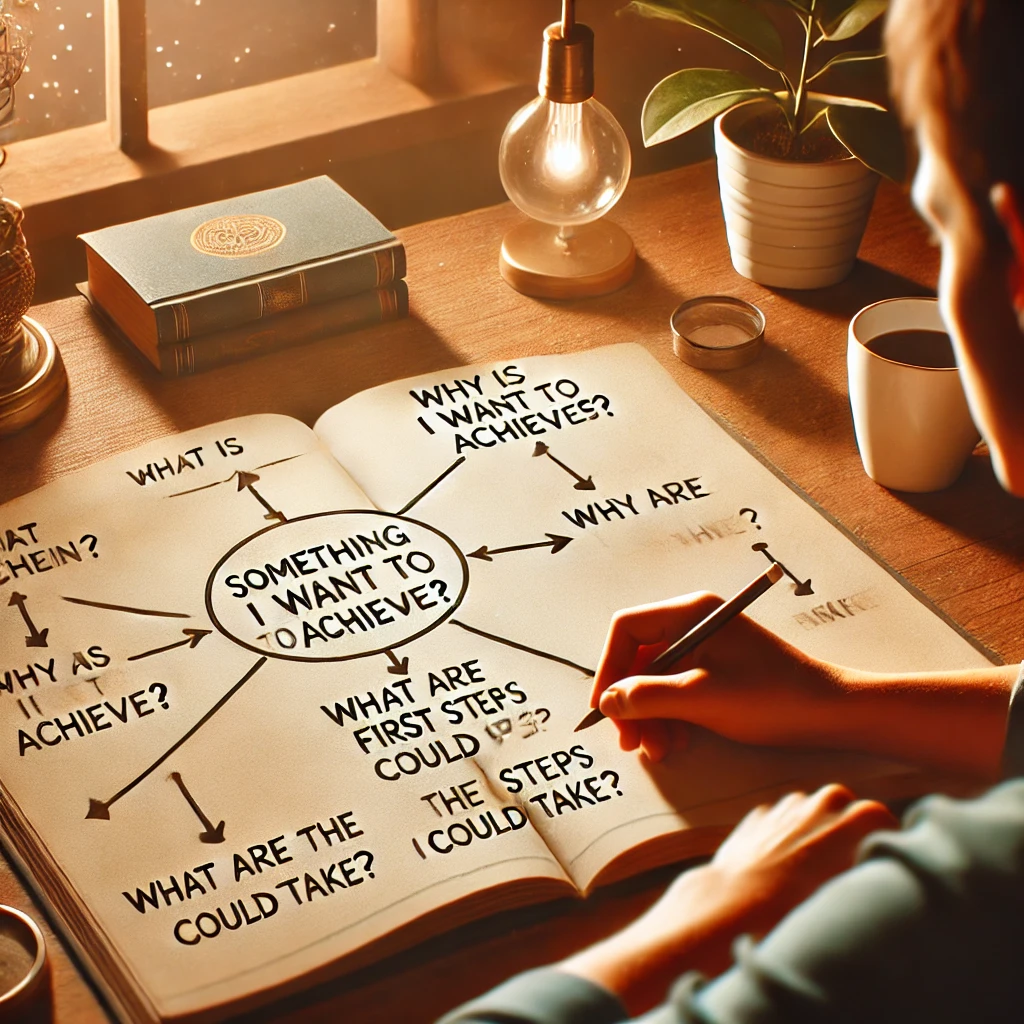
A question chain is an introspective tool that encourages self-reflection and goal-setting through a series of linked questions. By starting with one question and allowing it to lead to others, you can explore motivations, clarify values, and uncover hidden thoughts. Here’s how to get started, with examples to help you build your own question chains.
What is a Question Chain?
A question chain starts with a single question on a topic you want to explore. This question then branches into follow-up questions that dive deeper into your motivations and thoughts, leading to greater insight. It’s ideal for tackling goals, understanding challenges, or simply exploring what’s important to you.
ow to Create Your Own Question Chain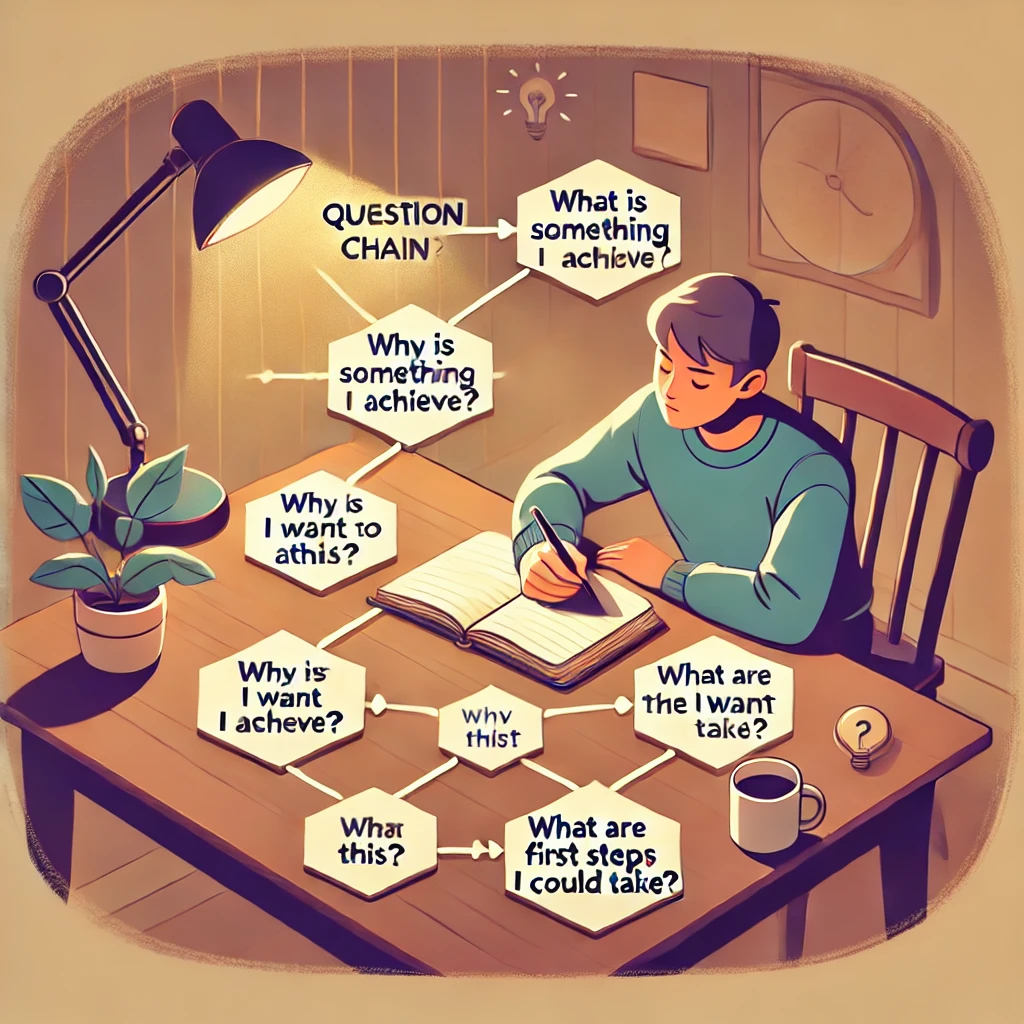
To begin, choose a topic or an area of life you want to focus on. Here are some popular topics an starter questions:
1. **Setting a Goal**
- Start with: “What is something I want to achieve?”
- Follow-up questions:
- “Why do I want this?”
- “What would achieving it mean to me?”
- “What steps can I take to move closer to this goal?”
- “What might stand in my way, and how can I overcome it?”
2. **Understanding a Challenge**
- Start with: “What’s something I find difficult right now?”
- Follow-up questions:
- “What specifically about this is challenging for me?”
- “How have I successfully managed similar situations?”
- “What resources or support could help me tackle this?”
- “What would success look like in this situation?”
3. **Exploring Values**
- Start with: “What is truly important to me?”
- Follow-up questions:
- “Why is this important?”
- “How does this value show up in my daily life?
- “What actions can I take to align more with this value?”
- “How would my life change if I prioritized this?”
Benefits of Using Question Chains
Creating a question chain encourages you to examine layers of thoughts that often go unnoticed. This approach provides a structured way to explore motivations, brainstorm actions, and find clarity.
10 Essential Journal Activities
10 Essential Journal Activities
1. Daily Gratitude
Why: Cultivates a positive mindset by shifting focus toward what’s going well.
How: List three things you’re grateful for each morning or evening, no matter how big or small.
2. Goal Setting and Tracking
Why: Helps set a clear path and keeps you accountable.
How: Start each week by writing down specific goals and check in on progress each day, recording obstacles and breakthroughs.
3. Mindful Reflection
Why: Builds self-awareness and mindfulness by allowing you to understand your thoughts and emotions.
How: Each night, reflect on your day, asking questions like, "What did I learn?" or "What could I have done better?"
4. Prompt-Based Self-Exploration
Why: Encourages deep introspection and fosters new perspectives.
How: Use prompts like, "What makes me truly happy?" or "What are my core values?" to dive deeper into your beliefs and desires.
5. Habit Tracking
Why: Reinforces positive habits and shows you areas for improvement.
How: Track small habits, such as reading, exercising, or meditating, by marking them off daily or weekly.
6. Growth Mindset Journaling
Why: Strengthens resilience by focusing on lessons from setbacks.
How: When something doesn’t go as planned, write about what happened, how it felt, and what you learned from the experience.
7. Visualization and Future Self
Why: Inspires motivation by clarifying your long-term vision.
How: Write about your ideal future self, envisioning where you’ll be in five or ten years, and explore the actions needed to get there.
8. Monthly Review and Planning
Why: Provides a bigger picture and helps you stay aligned with long-term goals.
How: At the end of each month, review accomplishments, challenges, and areas for growth. Then, plan the focus for the upcoming month.
9. Creativity and Idea Journaling
Why: Fosters innovation by giving space for ideas to develop.
How: Write down any ideas, no matter how big or small. This is a space for brainstorming without judgment.
10. Mind Dumping (Brainstorming)
Why: Reduces mental clutter by letting you get all thoughts out on paper.
How: When you feel overwhelmed, simply write down whatever comes to mind without structure to help clarify and prioritize tasks or emotions.
These activities collectively support a well-rounded journaling practice that nurtures personal growth, accountability, and a deeper understanding of oneself.
Cause and Effect in the Realm of Thought
Cause and Effect in the Realm of Thought
In the realm of human thought, the principle of cause and effect operates as one of the most fundamental forces, shaping our perceptions, decisions, and ultimately, our realities. Every thought that passes through our minds has a cause — whether it’s a memory, an emotion, or an external trigger — and every thought leads to a unique effect, influencing our actions, emotions, and mental well-being. Understanding how cause and effect work in the realm of thought isn’t only fascinating; it’s transformative. This principle has the power to bring awareness to our thinking, empower intentional thought patterns, and reshape our inner and outer worlds.
The Mechanics of Thought: How Causes Create Effects
The human brain is an intricate network of neurons, continuously firing and forming connections. These neural connections represent our thoughts, memories, and learning patterns. When a specific thought arises, it is often triggered by a stimulus, which is the “cause.” This cause could be an external stimulus — like seeing an old photograph that evokes memories — or an internal one, such as a deeply embedded belief that shapes responses to everyday situations.
The effect of any thought can vary widely. A thought’s effect might be a shift in mood, an action taken, or even the formation of new habits over time. For example, a single thought of self-doubt, if repeated, can lead to diminished self-confidence and hesitancy in decision-making. On the flip side, positive, affirming thoughts can build self-belief and create a ripple effect of confident actions and resilience.
Why Awareness of Cause and Effect in Thought Matters
The awareness of cause and effect in thought is powerful. If we can identify what triggers our thoughts, we gain control over our reactions and emotional responses. Instead of living on “auto-pilot” — reacting unconsciously to every thought and feeling that arises — we can step back, observe, and choose our responses. This practice of awareness, often called “metacognition,” is at the core of many mental health and self-improvement techniques.
Consider the cycle of stress as an example. A stressful thought — “I’ll never get this work done on time” — could be caused by an external deadline. Without awareness, this thought could spiral into anxiety, leading to decreased productivity and more stress. With awareness, however, we can identify the root of the thought, question its validity (“I’ve met deadlines like this before”), and replace it with a more constructive thought (“I’ll tackle this one step at a time”). This shift in thinking can completely change the outcome of a stressful situation.
Positive vs. Negative Thought Cycles
The principle of cause and effect is neutral; it’s not inherently positive or negative. Yet, the direction of our thought cycles — whether they lean toward positivity or negativity — determines the quality of our experiences and outcomes. Positive thought cycles generally lead to constructive actions, uplifting emotions, and resilient responses to challenges. Conversely, negative thought cycles often lead to discouraging actions, emotional turbulence, and a sense of stagnation.
Take the example of self-talk, the running inner dialogue we all have. A person who constantly thinks, “I’m not good enough,” may experience low self-esteem, which becomes a self-fulfilling prophecy. This thought cycle can limit opportunities for growth, as the person may be less likely to take on challenges or pursue goals. Conversely, someone who believes, “I can learn and improve” is more likely to try new things, gain skills, and build confidence. This belief becomes the cause of actions that lead to positive personal growth.
Cultivating a Mindset of Intentional Thinking
To use cause and effect in thought to our advantage, intentional thinking is essential. Intentional thinking is the practice of directing thoughts with purpose, aligning them with our goals, values, and well-being. Practicing intentional thinking allows us to proactively create positive thought cycles rather than passively reacting to whatever thought arises.
Mindfulness practices, such as meditation and journaling, are valuable tools for cultivating intentional thinking. Meditation helps us observe our thoughts without judgment, offering a clear view of the patterns and causes driving them. Journaling provides a similar benefit, allowing us to dissect thoughts, identify recurring themes, and set intentions for how we want to think and act.
Harnessing the Power of Cause and Effect to Shape Reality
In the realm of thought, cause and effect have a cumulative impact. A single positive thought might not change much, but the regular practice of positive thinking can gradually transform one’s mindset, mood, and actions. Over time, intentional thoughts cause us to take steps that bring about desired effects in reality.
This concept underlies the popular “law of attraction,” where the belief is that the energy of our thoughts influences our reality. While this can seem abstract, there’s science behind the notion that consistent thought patterns create habitual behaviors. Neuroplasticity — the brain’s ability to rewire itself based on new patterns and experiences — demonstrates how we can “rewire” our brains by intentionally choosing which thoughts to cultivate.
Practical Steps to Create Positive Thought Cycles
1. Identify Triggers: Recognize external and internal factors that commonly influence your thoughts. Are there particular situations or beliefs that lead to negative thinking?
2. Challenge Negative Thoughts: When negative thoughts arise, question them. Are they accurate reflections of reality, or are they distorted by fear, doubt, or past experiences?
3. Replace with Constructive Thoughts: Once you’ve challenged a negative thought, replace it with a more constructive one. Instead of thinking, “I can’t do this,” try, “I will try my best and learn from the experience.”
4. Visualize Positive Outcomes: Visualizing the positive effects of your thoughts can reinforce them. If you think, “I’m capable of succeeding in this project,” picture yourself achieving success.
5. Practice Gratitude: Gratitude is a powerful practice for cultivating positive thought cycles. By focusing on what we’re thankful for, we shift our mindset towards optimism and appreciation, which causes further positive thoughts and emotions.
Conclusion: Creating Change from Within
The principle of cause and effect in the realm of thought highlights our ability to shape our own mental and emotional experiences. By understanding and working with this principle, we move from being passive recipients of our thoughts to active creators of our mental environment. Thought by thought, we hold the potential to create a ripple effect of positive changes within and beyond ourselves, proving that even the smallest of thoughts can have a powerful impact on the life we experience.
- Audio Articles
- Audio Articles 1
- Audio Articles 2
- Audio Articles 3
- Audio Articles 4

7 Daily Disciplines That Transform Your Life
The power to act with intention, to align your actions with your values, and to move steadily toward a life of purpose—even on days you don't feel like it.
Read Full Article
How to Build Unbreakable Discipline
Discipline is built—habit by habit, choice by choice, day by day. And the most powerful kind? The kind that doesn’t crack under pressure. The kind that becomes part of who you are.
Read Full Article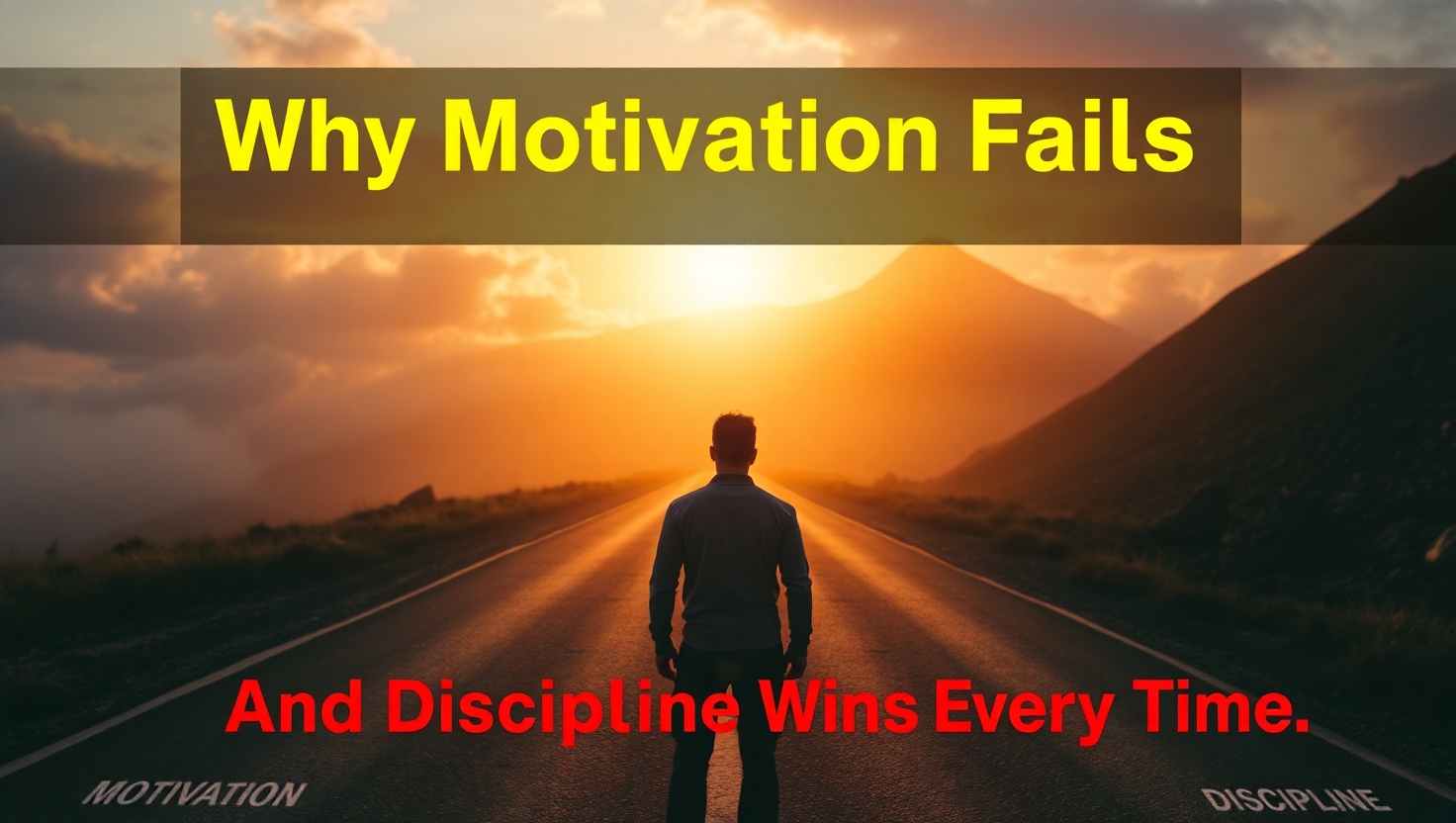
Why Motivation Fails And Discipline Wins Every Time
We all love the feeling of motivation—that surge of energy, that rush of inspiration that makes everything seem possible. But here’s the problem: motivation is unreliable. It’s emotional. It comes and goes. And if your goals rely on you “feeling like it,” you’re already in trouble.
Read Full Article
Discipline Over Desire
Desire is loud. It burns bright, talks fast, and loves to dream. But desire alone doesn't achieve much. Every person has desires. Very few have the discipline to bring them to life.
Read Full Article
The Science of Sticking
If you've ever tried to build a new habit, you've probably heard that it takes 21 days. This number gets thrown around so often that it feels like scientific fact.
Read Full Article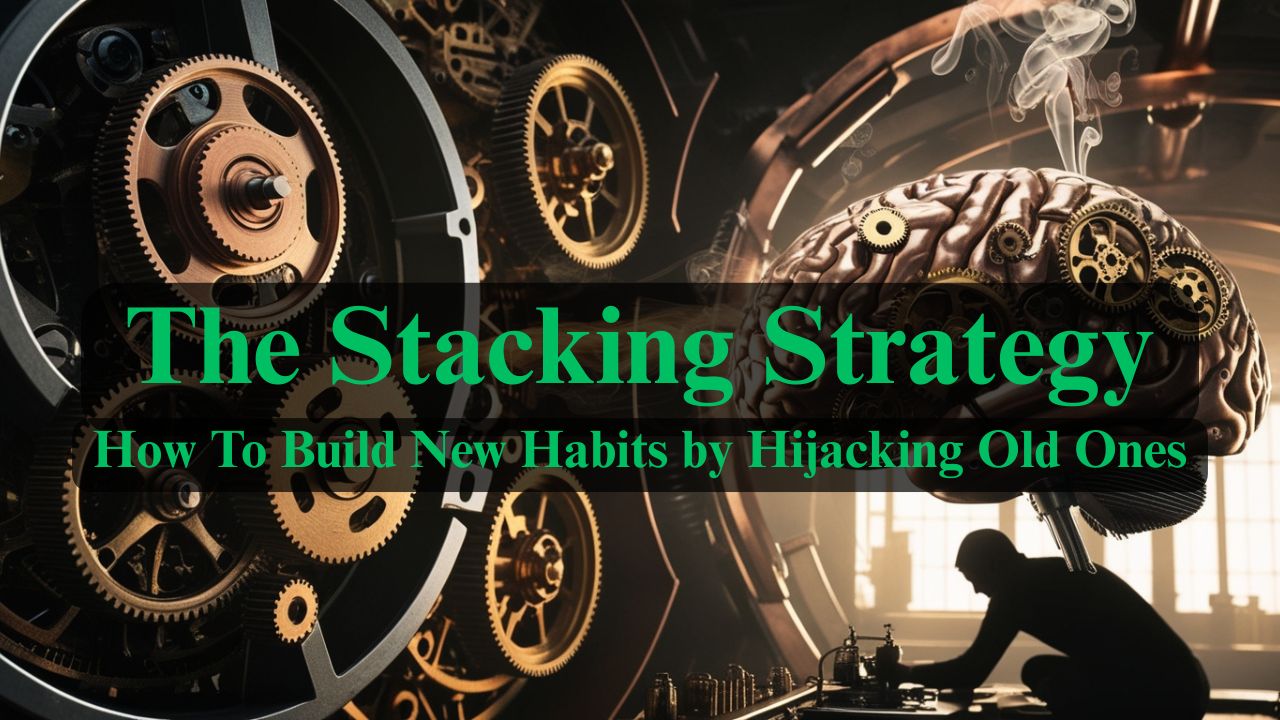
The Stacking Strategy
What if I told you that the habits you already have—even the ones you consider "bad"—could become the secret weapons for building the habits you want?
Read Full Article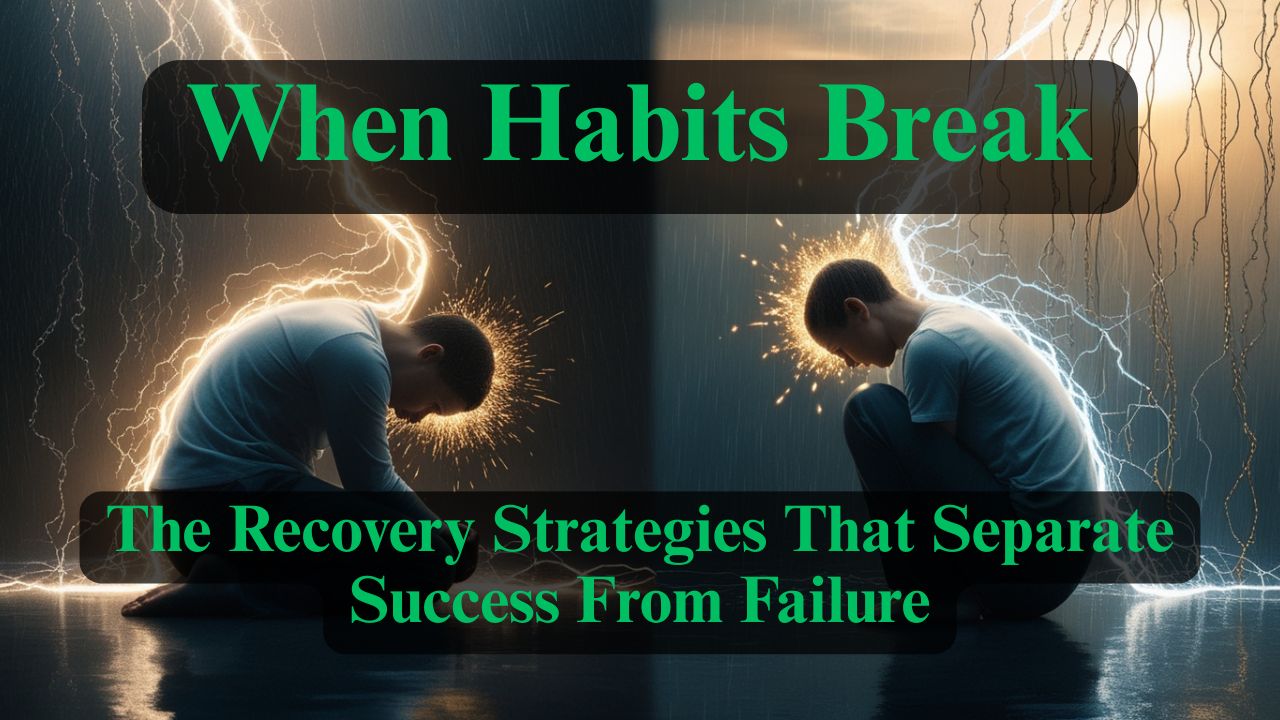
When Habits Fail - The Recovery Strategies That Separate Success From Failure
Here's what nobody tells you about building habits: you will fail. You'll miss days. You'll fall off track. You'll have weeks where everything falls apart.
Read Full Article
The Ultimate System - Designing a Life Where Good Habits Are Inevitable
You've learned to recognize habits, understand their formation timeline, stack them strategically, and recover from setbacks.
Read Full Article
